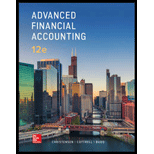
Advanced Financial Accounting
12th Edition
ISBN: 9781259916977
Author: Christensen, Theodore E., COTTRELL, David M., Budd, Cassy
Publisher: Mcgraw-hill Education,
expand_more
expand_more
format_list_bulleted
Concept explainers
Question
Chapter 17, Problem 17.7Q
To determine
Budgetary aspect of governmental operations: the governmental accounting uses budgets to assist in management control and to provide legal authority to levy taxes, and collect revenue, and make expenditures in accordance with budget. A government unit may have several types of budgets which includes.
- Operating budgets that specify expected revenue from various sources provided by law. The operating budget includes expected expenditures such as employees payrolls, supplies etc.
- Capital budgets to provide information about proposed construction projects.
To explain: what is meant by budgetary accounting? Explain the accounting for expected revenue and anticipated expenditure?
Expert Solution & Answer
Want to see the full answer?
Check out a sample textbook solution
Students have asked these similar questions
Can you solve this general accounting problem with appropriate steps and explanations?
What is the ending equity for reed enterprises? Accounting Question
Please explain the solution to this general accounting problem using the correct accounting principles.
Chapter 17 Solutions
Advanced Financial Accounting
Ch. 17 - Prob. 17.1QCh. 17 - What are the nine funds that local and state...Ch. 17 - Compare the modified accrual basis with the...Ch. 17 - Prob. 17.4QCh. 17 - When are property taxes recognized as revenue in...Ch. 17 - Prob. 17.6QCh. 17 - Prob. 17.7QCh. 17 - Are all expenditures encumbered?Ch. 17 - Prob. 17.9QCh. 17 - Prob. 17.10Q
Ch. 17 - When is the expenditure for inventories recognized...Ch. 17 - Prob. 17.12QCh. 17 - Prob. 17.13QCh. 17 - Prob. 17.14QCh. 17 - Prob. 17.15QCh. 17 - Prob. 17.1CCh. 17 - Prob. 17.2CCh. 17 - Prob. 17.3CCh. 17 - Prob. 17.1.1ECh. 17 - Prob. 17.1.2ECh. 17 - Prob. 17.1.3ECh. 17 - Prob. 17.1.4ECh. 17 - Prob. 17.1.5ECh. 17 - Prob. 17.2ECh. 17 - Prob. 17.3.1ECh. 17 - Prob. 17.3.2ECh. 17 - Prob. 17.3.3ECh. 17 - Prob. 17.3.4ECh. 17 - Prob. 17.3.5ECh. 17 - Prob. 17.3.6ECh. 17 - Prob. 17.3.7ECh. 17 - Prob. 17.3.8ECh. 17 - Prob. 17.3.9ECh. 17 - Prob. 17.3.10ECh. 17 - Prob. 17.4.1ECh. 17 - Prob. 17.4.2ECh. 17 - Prob. 17.4.3ECh. 17 - Prob. 17.4.4ECh. 17 - Prob. 17.4.5ECh. 17 - Prob. 17.4.6ECh. 17 - Prob. 17.4.7ECh. 17 - Prob. 17.4.8ECh. 17 - Prob. 17.4.9ECh. 17 - Prob. 17.4.10ECh. 17 - Prob. 17.5ECh. 17 - Prob. 17.6ECh. 17 - Prob. 17.7ECh. 17 - Computation of Revenues Reported on the Statement...Ch. 17 - Prob. 17.9ECh. 17 - Prob. 17.10ECh. 17 - Prob. 17.11ECh. 17 - Prob. 17.12ECh. 17 - General Fund Entries [AICPA Adapted] The following...Ch. 17 - Prob. 17.14PCh. 17 - Prob. 17.15PCh. 17 - Prob. 17.16PCh. 17 - Prob. 17.17PCh. 17 - Prob. 17.18.1PCh. 17 - Prob. 17.18.2PCh. 17 - Prob. 17.18.3PCh. 17 - Prob. 17.18.4PCh. 17 - Prob. 17.18.5PCh. 17 - Prob. 17.18.6PCh. 17 - Prob. 17.18.7PCh. 17 - Prob. 17.18.8PCh. 17 - Prob. 17.18.9PCh. 17 - Prob. 17.18.10PCh. 17 - Prob. 17.18.11PCh. 17 - Prob. 17.18.12PCh. 17 - Prob. 17.18.13PCh. 17 - Prob. 17.18.14PCh. 17 - Prob. 17.18.15PCh. 17 - Prob. 17.18.16PCh. 17 - Prob. 17.18.17PCh. 17 - Prob. 17.18.18PCh. 17 - Prob. 17.18.19PCh. 17 - Prob. 17.18.20PCh. 17 - Prob. 17.18.21PCh. 17 - Prob. 17.18.22PCh. 17 - Prob. 17.18.23PCh. 17 - Prob. 17.18.24PCh. 17 - Prob. 17.18.25PCh. 17 - Prob. 17.18.26PCh. 17 - Prob. 17.18.27PCh. 17 - General Fund Entries [AICPA Adapted] DeKalb City...Ch. 17 - Prob. 17.18.29PCh. 17 - Prob. 17.18.30PCh. 17 - Prob. 17.18.31PCh. 17 - General Fund Entries [AICPA Adapted] DeKalb City...Ch. 17 - Prob. 17.18.33PCh. 17 - Prob. 17.18.34PCh. 17 - Prob. 17.18.35PCh. 17 - General Fund Entries [AICPA Adapted] DeKalb City...Ch. 17 - Prob. 17.18.37PCh. 17 - Prob. 17.18.38PCh. 17 - Prob. 17.18.39PCh. 17 - Prob. 17.19PCh. 17 - Prob. 17.20P
Knowledge Booster
Learn more about
Need a deep-dive on the concept behind this application? Look no further. Learn more about this topic, accounting and related others by exploring similar questions and additional content below.Similar questions
- Question 1181 28 Current Attempt in Progress Here are comparative balance sheets for Migitsu Company. Prepare a statement of cash flows-indirect method. MIGITSU COMPANY Comparative Balance Sheets December 31 Assets 2020 2019 Cash $73,000 $22,000 Accounts receivable 87,000 76.000 Inventory 170,000 191.000 Land 72,000 100.000 Equipment 260,000 200.000 Accumulated depreciation - equipment (66,000) (32.000) Total $596,000 $557,000 Liabilities and Stockholders' Equity Accounts payable $37,000 $47.000 Bonds payable 150,000 210,000 Common stock ($1 par) 216.000 174,000 Retained earnings 193,000 126.000 Total $596,000 $557,000 Additional information: 1 Net income for 2020 was $100,000. N Cash dividends of $33,000 were declared and paid. 3. Bonds payable amounting to $60,000 were redeemed for cash $60,000. -18 4. Common stock was issued for $42,000 cash. 5. Equipment that cost $50,000 and had a book value of $30,000 was sold for $36,000 during 2020; land was sold at cost.arrow_forwardI need guidance with this general accounting problem using the right accounting principles.arrow_forwardI need assistance with this general accounting question using appropriate principles.arrow_forward
arrow_back_ios
SEE MORE QUESTIONS
arrow_forward_ios
Recommended textbooks for you
- Principles of Accounting Volume 2AccountingISBN:9781947172609Author:OpenStaxPublisher:OpenStax College
 Survey of Accounting (Accounting I)AccountingISBN:9781305961883Author:Carl WarrenPublisher:Cengage Learning
Survey of Accounting (Accounting I)AccountingISBN:9781305961883Author:Carl WarrenPublisher:Cengage Learning  Cornerstones of Cost Management (Cornerstones Ser...AccountingISBN:9781305970663Author:Don R. Hansen, Maryanne M. MowenPublisher:Cengage Learning
Cornerstones of Cost Management (Cornerstones Ser...AccountingISBN:9781305970663Author:Don R. Hansen, Maryanne M. MowenPublisher:Cengage Learning

Principles of Accounting Volume 2
Accounting
ISBN:9781947172609
Author:OpenStax
Publisher:OpenStax College


Survey of Accounting (Accounting I)
Accounting
ISBN:9781305961883
Author:Carl Warren
Publisher:Cengage Learning

Cornerstones of Cost Management (Cornerstones Ser...
Accounting
ISBN:9781305970663
Author:Don R. Hansen, Maryanne M. Mowen
Publisher:Cengage Learning
Responsibility Accounting| Responsibility Centers and Segments| US CMA Part 1| US CMA course; Master Budget and Responsibility Accounting-Intro to Managerial Accounting- Su. 2013-Prof. Gershberg; Author: Mera Skill; Rutgers Accounting Web;https://www.youtube.com/watch?v=SYQ4u1BP24g;License: Standard YouTube License, CC-BY